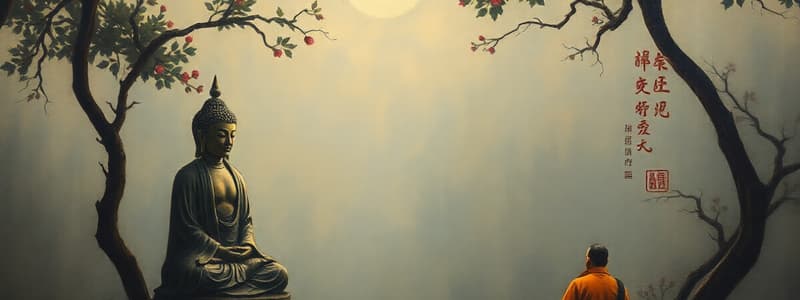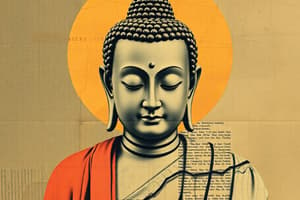Podcast
Questions and Answers
What pivotal realization led Siddhartha Gautama to adopt the Middle Way?
What pivotal realization led Siddhartha Gautama to adopt the Middle Way?
- The necessity of extreme asceticism for achieving enlightenment.
- The futility of material wealth in attaining inner peace.
- The ineffectiveness of royal life in preventing suffering.
- The inadequacy of self-indulgence and self-mortification. (correct)
Which of the following is NOT one of the three 'baskets' (pitakas) comprising the Pali Canon?
Which of the following is NOT one of the three 'baskets' (pitakas) comprising the Pali Canon?
- Vinaya Pitaka
- Sutta Pitaka
- Jataka Pitaka (correct)
- Abhidhamma Pitaka
How did Greco-Buddhist art influence the representation of the Buddha?
How did Greco-Buddhist art influence the representation of the Buddha?
- By initiating the human representation of the Buddha. (correct)
- By introducing the concept of stupas.
- By promoting symbolic representations like footprints.
- By standardizing the design of pagodas.
Which concept, central to Buddhist ethics, has significantly shaped moral and social norms in Asian cultures?
Which concept, central to Buddhist ethics, has significantly shaped moral and social norms in Asian cultures?
Which of the following facilitated the dissemination of Buddhism along the Silk Road?
Which of the following facilitated the dissemination of Buddhism along the Silk Road?
Among the Mahayana Sutras, which one elucidates the doctrine of emptiness (sunyata)?
Among the Mahayana Sutras, which one elucidates the doctrine of emptiness (sunyata)?
How did Emperor Ashoka contribute to the spread of Buddhism beyond India?
How did Emperor Ashoka contribute to the spread of Buddhism beyond India?
What distinguishes Vajrayana Buddhism from other forms of Buddhism?
What distinguishes Vajrayana Buddhism from other forms of Buddhism?
What role do Viharas play in Buddhism?
What role do Viharas play in Buddhism?
Which of the following is a common characteristic of Buddhist art and architecture?
Which of the following is a common characteristic of Buddhist art and architecture?
Flashcards
Who was Siddhartha Gautama?
Who was Siddhartha Gautama?
Founder of Buddhism, born Siddhartha Gautama in Lumbini around 563 BCE.
What is the Middle Way?
What is the Middle Way?
The path of moderation between self-indulgence and self-mortification adopted by Siddhartha Gautama.
What is the Sangha?
What is the Sangha?
The monastic order of monks and nuns established by the Buddha to preserve and propagate his teachings.
What is the Pali Canon (Tipitaka)?
What is the Pali Canon (Tipitaka)?
Signup and view all the flashcards
What is the Vinaya Pitaka?
What is the Vinaya Pitaka?
Signup and view all the flashcards
What is the Sutta Pitaka?
What is the Sutta Pitaka?
Signup and view all the flashcards
What is the Abhidhamma Pitaka?
What is the Abhidhamma Pitaka?
Signup and view all the flashcards
What are Stupas?
What are Stupas?
Signup and view all the flashcards
What are Chaityas?
What are Chaityas?
Signup and view all the flashcards
What are Viharas?
What are Viharas?
Signup and view all the flashcards
Study Notes
- Buddhism originated in ancient India and has profoundly influenced Asian cultures.
- The notes cover the life of Buddha, Buddhist texts and scriptures, art and architecture, its influence on Asian cultures, and its spread.
Life of Buddha
- Siddhartha Gautama, born in Lumbini (present-day Nepal) around 563 BCE, was the founder of Buddhism.
- He was born into a royal family of the Shakya clan.
- A prophecy foretold that he would either become a great king or a renunciate.
- Sheltered from suffering, Siddhartha lived a privileged life.
- At 29, he encountered old age, sickness, and death, prompting a profound existential crisis.
- Renouncing his royal life, Siddhartha became an ascetic, seeking enlightenment through extreme deprivation.
- Finding asceticism ineffective, he adopted the Middle Way, a path of moderation between self-indulgence and self-mortification.
- He meditated under a Bodhi tree in Bodh Gaya, achieving enlightenment and becoming the Buddha ("the awakened one").
- After enlightenment, the Buddha delivered his first sermon in Sarnath, setting in motion the "Wheel of Dharma."
- He spent the remainder of his life traveling and teaching across the Ganges River basin.
- The Buddha established the Sangha, a monastic order of monks and nuns, to preserve and propagate his teachings.
- The Buddha died at Kusinara around 483 BCE at the age of 80.
Buddhist Texts and Scriptures
- Buddhist scriptures are vast and diverse, varying across different Buddhist traditions.
- The earliest Buddhist texts were transmitted orally for centuries before being written down.
- The Pali Canon (Tipitaka) is the most complete collection of early Buddhist texts, preserved in the Pali language.
- The Pali Canon consists of three "baskets" (pitakas): Vinaya Pitaka (rules for monastic life), Sutta Pitaka (discourses of the Buddha), and Abhidhamma Pitaka (philosophical analysis).
- The Vinaya Pitaka contains rules and guidelines for monks and nuns, covering aspects of monastic discipline and conduct.
- The Sutta Pitaka contains discourses and sermons attributed to the Buddha and his close disciples.
- The Abhidhamma Pitaka presents systematic analyses of Buddhist doctrines, exploring psychology, metaphysics, and epistemology.
- Mahayana Sutras are a collection of texts central to Mahayana Buddhism, emphasizing the Bodhisattva ideal.
- Some important Mahayana Sutras include the Lotus Sutra, Heart Sutra, and Diamond Sutra.
- The Lotus Sutra emphasizes the potential for all beings to achieve Buddhahood.
- The Heart Sutra presents the doctrine of emptiness (sunyata), a key concept in Mahayana philosophy.
- The Diamond Sutra explores the nature of reality and the illusion of fixed identities.
- Tantric texts (Tantras) are associated with Vajrayana Buddhism, containing esoteric teachings and practices.
- These texts often involve mantras, mandalas, and visualizations for spiritual transformation.
Buddhist Art and Architecture
- Buddhist art and architecture reflect the teachings of Buddhism and its cultural adaptations across different regions.
- Early Buddhist art (2nd century BCE - 1st century CE) focused on symbolic representations of the Buddha, such as footprints, the Bodhi tree, or the Dharma wheel.
- The human representation of the Buddha emerged later, influenced by Greco-Buddhist art in Gandhara.
- Common motifs in Buddhist art include the Buddha's life events, Jataka tales, and depictions of bodhisattvas and deities.
- Stupas are dome-shaped monuments containing relics of the Buddha or important Buddhist figures, serving as sites for pilgrimage and veneration.
- Sanchi Stupa in India is one of the oldest and most well-preserved examples of early Buddhist architecture.
- Chaityas are prayer halls containing a stupa, often found in rock-cut caves.
- Ajanta and Ellora caves in India feature elaborate chaityas and monasteries with intricate sculptures and paintings.
- Viharas are monasteries serving as residences for monks and centers for learning and practice.
- Pagodas are tiered towers, commonly found in East Asia, evolving from the Indian stupa.
- Buddhist art and architecture often incorporate symbols such as the lotus flower (purity), the Dharma wheel (Buddha's teachings), and mandalas (cosmic diagrams).
Buddhism and Its Influence on Asian Cultures
- Buddhism has deeply influenced the cultures, philosophies, and values of many Asian countries, including India, Sri Lanka, Tibet, China, Korea, Japan, Thailand, and Myanmar.
- Buddhist ethics, emphasizing non-violence, compassion, and mindfulness, have shaped moral and social norms.
- The concept of karma and rebirth has influenced beliefs about destiny, morality, and the afterlife.
- Buddhist philosophy has contributed to intellectual and spiritual traditions, influencing art, literature, and education.
- Meditation and mindfulness practices, derived from Buddhist teachings, have gained popularity for stress reduction and well-being.
- Buddhist institutions, such as monasteries and temples, have served as centers for education, community service, and cultural preservation.
- Buddhist festivals, such as Vesak (Buddha's birthday) and the Rain Retreat, are important cultural events in many Asian countries.
- Buddhist art and architecture have enriched the cultural heritage of Asia, with iconic monuments and artistic traditions.
Spread of Buddhism
- Buddhism spread from India to other parts of Asia through trade routes, missionary activities, and cultural exchange.
- During the reign of Emperor Ashoka (3rd century BCE), Buddhism was promoted through edicts and missionary efforts.
- Ashoka sent missionaries to Sri Lanka, Southeast Asia, and Central Asia, facilitating the spread of Buddhism.
- Theravada Buddhism became dominant in Sri Lanka and Southeast Asia, emphasizing the teachings of the Pali Canon.
- Mahayana Buddhism spread to Central Asia, China, Korea, and Japan, incorporating new sutras and philosophical concepts.
- Vajrayana Buddhism developed in Tibet, incorporating tantric practices and unique monastic traditions.
- The Silk Road played a crucial role in the transmission of Buddhism to China, with monks, merchants, and pilgrims facilitating the exchange of ideas and texts.
- Buddhism adapted to local cultures and beliefs as it spread, leading to diverse forms of Buddhist practice and expression.
- In modern times, Buddhism has spread to the West, attracting followers interested in meditation, mindfulness, and Buddhist philosophy.
- Buddhist centers and communities have been established in many Western countries, contributing to interfaith dialogue and cultural exchange.
Studying That Suits You
Use AI to generate personalized quizzes and flashcards to suit your learning preferences.




